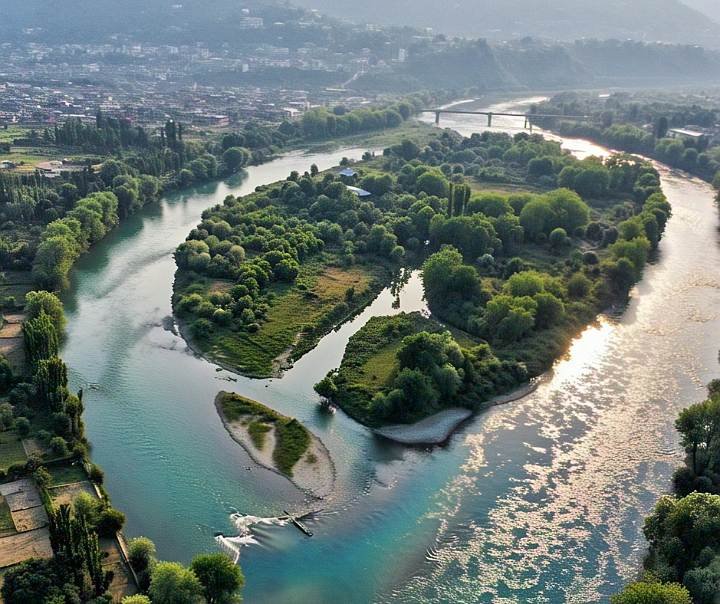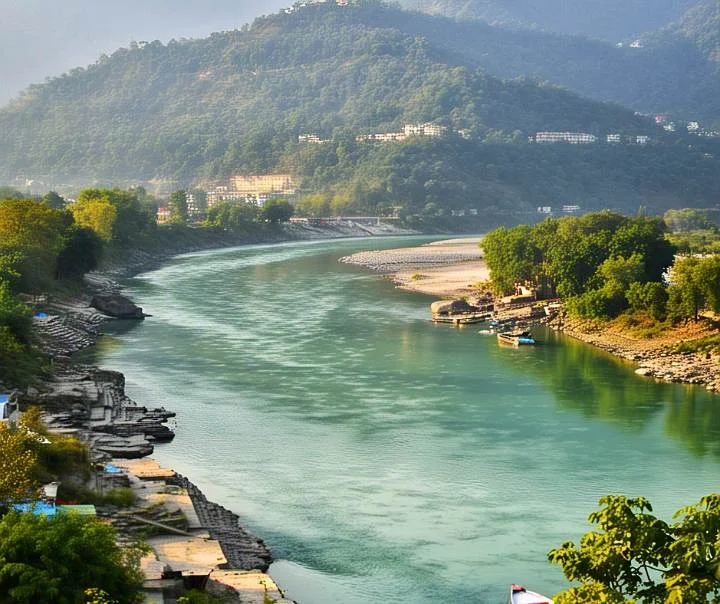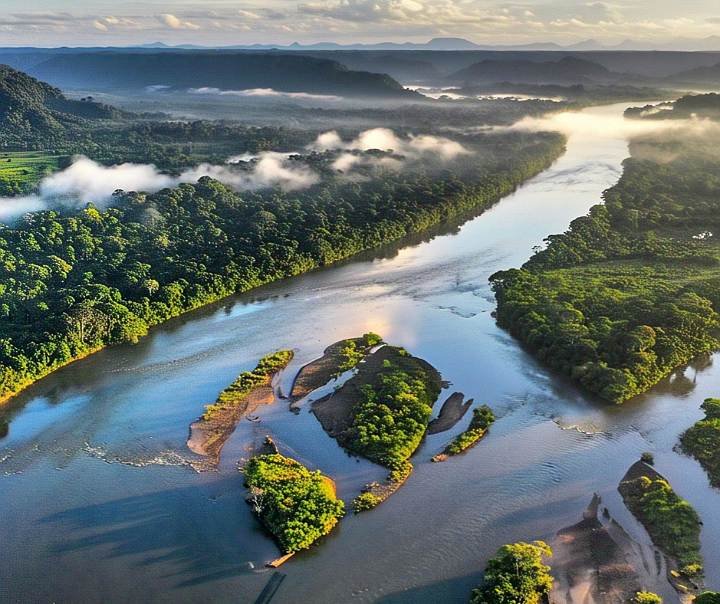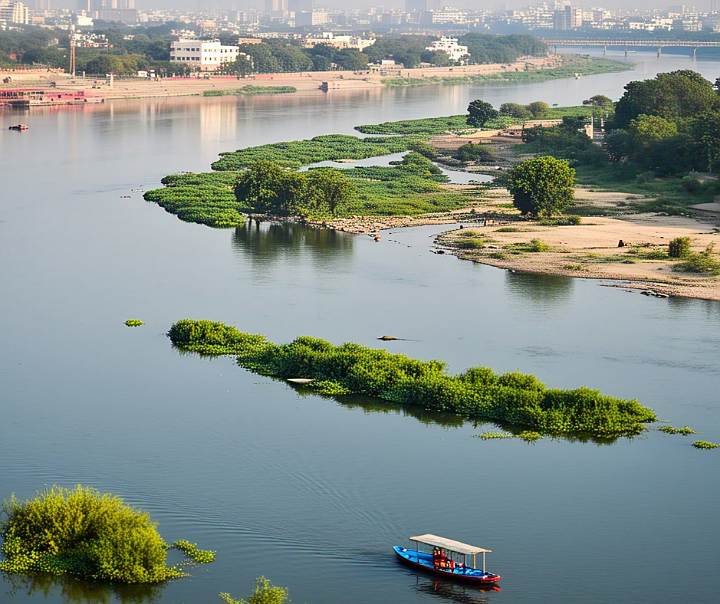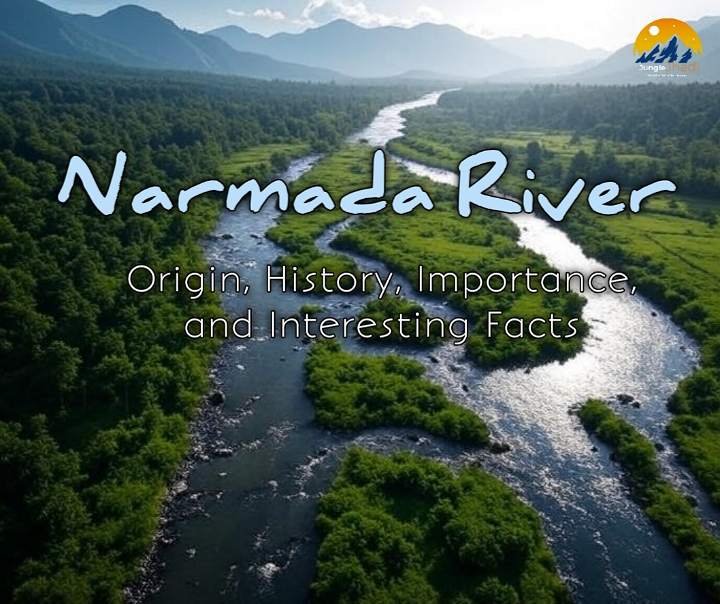Godavari River : A Comprehensive Journey from Source to Sea
The Godavari River, often referred to as the Dakshin Ganga (Southern Ganga) or Vridha Ganga, is India’s second-longest river and the largest in peninsular India. It is not just a source of water but also holds immense cultural, religious, and economic significance. In this detailed blog post, we will explore the Godavari’s entire journey from its origin to its confluence with the sea, its tributaries, associated facts, history, projects, biodiversity, and other relevant information.
Introduction to the Godavari River
The Godavari River is one of India’s most vital rivers, stretching approximately 1,465 kilometers (910 miles) before merging into the Bay of Bengal. Its basin area spans 312,812 square kilometers, covering about 10% of India’s total geographical area. The river flows through the states of Maharashtra, Telangana, Andhra Pradesh, Chhattisgarh, and Odisha, while also touching small parts of Madhya Pradesh, Karnataka, and Puducherry (Yanam).
In Hinduism, the Godavari is considered sacred and is often called the Southern Ganga due to its spiritual and cultural importance in South India. The riverbanks host numerous pilgrimage sites, temples, and religious events, including the Kumbh Mela held every 12 years in Nashik. Beyond its spiritual significance, the Godavari provides drinking water, irrigation, and hydroelectric power to millions. Its delta region, known as Konaseema, is famous for its fertile land and is often called the Rice Bowl of South India.
The Origin of the Godavari River
The Godavari originates in the Western Ghats at Brahmagiri Hill near Trimbakeshwar in Nashik district, Maharashtra. This source lies at an elevation of 1,067 meters above sea level, just 80 kilometers from the Arabian Sea. Trimbakeshwar is a significant religious site, home to the Trimbakeshwar Jyotirlinga Temple, one of the twelve sacred Jyotirlingas in India. The temple’s proximity to the river’s origin adds to its spiritual importance.

According to Hindu mythology, the Godavari was brought to Earth by Sage Gautam. Legend has it that Gautam Rishi prayed to Lord Shiva to absolve him of the sin of accidentally killing a cow. Pleased with his devotion, Shiva brought the Ganga to Trimbakeshwar, giving rise to the Godavari. This is why the river is also called Gautami. Learn more about Trimbakeshwar Temple
The Journey of the Godavari River
The Godavari traverses diverse geographical and cultural landscapes during its journey. Its flow is primarily west to east, crossing the vast Deccan Plateau. Let’s break down its journey into key stages:
1. From Origin to Maharashtra
The Godavari river begins its journey at Trimbakeshwar as a swift stream and flows through various parts of Maharashtra. Near Nashik, it passes through sacred sites like Ramkund and other ghats, where devotees take holy dips. Nashik hosts the Kumbh Mela every 12 years, attracting millions of pilgrims.
In Maharashtra, the river is joined by several tributaries, such as the Darna, Kadva, and Purna. About 25 kilometers downstream from Nashik, it meets the Darna River. Further along, at Nandur-Madhmeshwar, it merges with the Kadva River, gaining strength. In Maharashtra, the river’s flow is relatively calm and steady, though it swells during the monsoon season.
2. Telangana and Chhattisgarh Border
After crossing Maharashtra, the Godavari river enters Telangana in its northern region. Near Nizamabad, it forms the border between Telangana and Maharashtra. Here, it is joined by the Pranahita River, a major tributary that significantly increases its water volume. The Pranahita itself is formed by the confluence of the Wardha, Wainganga, and Painganga rivers, making it the largest tributary of the Godavari.
In Telangana, the river’s flow is vital near Kaleshwaram, home to the Kaleshwaram Lift Irrigation Project. This project supplies water for irrigation and drinking purposes across several districts. More on Kaleshwaram Project
3. Eastern Ghats and Andhra Pradesh
Leaving Telangana, the Godavari river passes through a narrow section of the Eastern Ghats known as the Papi Hills. This region is renowned for its scenic beauty, where the river flows through a deep gorge, creating a mesmerizing landscape. The Papi Hills are a popular tourist destination, offering breathtaking views and boating experiences.
After crossing the Papi Hills, the river enters Andhra Pradesh, where it widens and flows through flat plains. At Rajahmundry (Rajamahendravaram), the river splits into two main branches: Gautami Godavari (north) and Vasishta Godavari (south). It further divides into five smaller distributaries, including Vainateya and Tulyabhaga.
4. Delta and the Bay of Bengal
About 80 kilometers from Rajahmundry, the Godavari forms a vast delta known as Konaseema. This delta, stretching 170 kilometers, is renowned for its fertile soil, supporting crops like rice, coconut, and bananas. The Godavari delta, along with the Krishna River delta, forms a critical agricultural hub in South India.
In the delta region, the river splits into multiple branches before merging into the Bay of Bengal. The Gautami Godavari branch meets the sea near Yanam (Puducherry), while the Vasishta Godavari and other distributaries join the sea at different points. The seven branches of the Godavari are associated with the Saptarishis (seven great sages), and bathing in them is considered part of the sacred Sapta Sagar Yatra.
Tributaries of the Godavari River
The Godavari’s strength and expanse are bolstered by its numerous tributaries, which join from both the left bank and right bank. Left-bank tributaries are larger and more numerous, covering 59.7% of the basin, while right-bank tributaries cover 16.1%. Below are the major tributaries of the Godavari:
Left-Bank Tributaries
- Purna River:
- Origin: Ajanta Hills, Maharashtra
- Length: 373 km
- Details: Joins the Godavari near Purna city. The Yeldari and Siddheshwar dams on this river support irrigation and water supply. Its tributaries include Kelna, Damna, and Dudhna.
- Pranahita River:
- Origin: Confluence of Wardha and Wainganga rivers, Maharashtra-Telangana border
- Length: 113 km
- Details: The largest tributary, covering 34% of the Godavari basin. It merges with the Godavari at Kaleshwaram, Telangana, carrying water from the Wardha, Wainganga, and Painganga rivers.
- Indravati River:
- Origin: Dandakaranya, Chhattisgarh
- Length: 535 km
- Details: A lifeline for Chhattisgarh and Odisha, it supports the Upper Indravati Project for hydropower and irrigation.
- Sabari River:
- Origin: Odisha
- Length: 418 km
- Details: Joins the Godavari before the Papi Hills, contributing to irrigation in Odisha and Chhattisgarh.
- Painganga River:
- Origin: Ajanta Hills, Maharashtra
- Length: 676 km
- Details: Flows along the Maharashtra-Telangana border and joins the Pranahita. The Upper Painganga Project is built on this river.
- Wardha River:
- Origin: Satpura Range, Madhya Pradesh
- Length: 528 km
- Details: Feeds into the Pranahita and supports the Vidarbha region. The Upper Wardha Dam is located here.
- Wainganga River:
- Origin: Satpura Range, Madhya Pradesh
- Length: 635 km
- Details: A key tributary of the Pranahita, it provides water to areas like Pench National Park and Tadoba Tiger Reserve.
Right-Bank Tributaries
- Pravara River:
- Origin: Western Ghats, Maharashtra
- Length: 208 km
- Details: Joins the Godavari above the Jayakwadi Dam. The Bhandardara and Nilwande dams are built on this river.
- Manjra River:
- Origin: Balaghat Range, Maharashtra
- Length: 724 km
- Details: The longest tributary, flowing through Maharashtra, Karnataka, and Telangana. The Nizam Sagar Dam is located here.
- Maner River:
- Origin: Rajanna Sircilla, Telangana
- Length: 225 km
- Details: Joins the Godavari in Telangana, with the Upper Maner Dam built on it.
- Kinnerasani River:
- Origin: Andhra Pradesh
- Details: A smaller tributary that joins the Godavari in Andhra Pradesh.
In addition to these, smaller tributaries like Bindusara, Pench, Kanhan, and Mula also contribute to the Godavari’s flow and basin.
Religious and Cultural Significance
The Godavari river holds a special place in Hinduism, revered as the Dakshin Ganga. Its banks are dotted with sacred pilgrimage sites and temples. Some key religious sites include:
- Trimbakeshwar (Maharashtra):
- Home to the Jyotirlinga Temple and the Godavari’s origin, it attracts devotees for holy dips and worship.
- Nashik (Maharashtra):
- Known for Ramkund and other ghats, Nashik hosts the Kumbh Mela every 12 years, a major Hindu festival.
- Bhadrachalam (Telangana):
- The Sri Rama Temple here is believed to be associated with Lord Rama’s exile. It is a prominent pilgrimage site.
- Basar (Telangana):
- The Gnana Saraswati Temple, dedicated to Goddess Saraswati, is a center for education and knowledge.
- Pattiseema (Andhra Pradesh):
- The Veerabhadra Swamy Temple, dedicated to Lord Veerabhadra and Goddess Bhadrakali, is located here.
The seven branches of the Godavari are linked to the Saptarishis (Kashyapa, Atri, Gautama, Jamadagni, Vishwamitra, Vasishta, and Bharadwaja). Bathing in these branches is considered highly auspicious. References to the Godavari are also found in ancient texts like the Ramayana and Mahabharata.
Economic Importance of the Godavari
The Godavari and its basin are a lifeline for millions, supporting various economic activities:
- Agriculture:
- The Konaseema delta is renowned for rice, coconut, banana, and other crops, earning the title Rice Bowl of South India. Tributaries and dams provide irrigation water.
- Hydropower:
- Several dams and projects on the Godavari and its tributaries generate electricity, including:
- Sriramsagar Project (Telangana)
- Jayakwadi Project (Maharashtra)
- Polavaram Project (Andhra Pradesh)
- Upper Indravati Project (Chhattisgarh)
- Fisheries:
- The basin supports over 228 fish species. The delta region is a hub for fish and shrimp farming.
- Tourism:
- Places like Papi Hills, Trimbakeshwar, Bhadrachalam, and Rajahmundry attract tourists for their natural beauty and spiritual significance.
- Industry:
- Cities like Nashik and Aurangabad use river water for industries such as automobiles, sugar, and oil extraction.
Biodiversity of the Godavari Basin
The Godavari basin is rich in biodiversity, hosting several wildlife sanctuaries and national parks:
- Tadoba Andhari Tiger Reserve (Maharashtra):
- Famous for its tiger population and diverse wildlife.
- Pench National Park (Maharashtra):
- The inspiration for Rudyard Kipling’s The Jungle Book.
- Indravati National Park (Chhattisgarh):
- Home to tigers, leopards, and other species.
- Coringa Mangrove Forest (Andhra Pradesh):
- India’s second-largest mangrove forest, supporting reptiles, fish, and migratory birds.
The basin is home to fish species like carp, mahseer, and prawns. The delta region serves as a nesting ground for Olive Ridley turtles.
Challenges Facing the Godavari
The Godavari and its basin face several challenges:
- Floods:
- The lower reaches, especially the delta, are prone to flooding during monsoons. In 2025, flood levels in Bhadrachalam crossed 50 feet.
- Droughts:
- Maharashtra’s Marathwada region frequently faces drought.
- Pollution:
- Industrial and domestic waste pollutes the river, affecting water quality and biodiversity.
- Inter-State Water Disputes:
- Water-sharing disputes among Andhra Pradesh, Telangana, Maharashtra, Chhattisgarh, and Odisha persist.
- Environmental Impact:
- Large dams and projects cause displacement, harm wildlife, and disrupt ecological balance.
Major Projects on the Godavari
Several dams and irrigation projects have been built on the Godavari and its tributaries, contributing to regional development:
- Sir Arthur Cotton Barrage (Andhra Pradesh):
- Built in 1852 by British engineer Arthur Cotton, it supports irrigation in the delta. It was modernized between 1970 and 1982.
- Polavaram Project (Andhra Pradesh):
- A multi-purpose project for irrigation, hydropower, and drinking water, it will also transfer water to the Krishna basin.
- Sriramsagar Project (Telangana):
- Located in Nizamabad, it provides irrigation and hydropower to multiple districts.
- Jayakwadi Project (Maharashtra):
- Situated in Paithan, it features a long dam wall and supports irrigation and water supply.
- Kaleshwaram Lift Irrigation Project (Telangana):
- Supplies water for agriculture and drinking across Telangana.
The Future of the Godavari
The Godavari’s future depends on effective management and conservation. Key steps include:
- Pollution Control:
- Strict regulations and treatment plants are needed to prevent industrial and domestic waste from entering the river.
- Flood and Drought Management:
- Improved dam management and water conservation schemes can mitigate floods and droughts.
- Climate Change:
- Changing rainfall patterns due to climate change require long-term water management plans.
- Inter-State Cooperation:
- Resolving water disputes through better coordination and strengthening the Godavari River Management Board (GRMB).
- Biodiversity Conservation:
- Efforts are needed to protect mangroves, national parks, and fish species.
Conclusion
The Godavari River is a priceless heritage of India, providing water, livelihoods, and spiritual solace to millions. Its journey from source to sea touches countless lives, supported by its tributaries, dams, and fertile delta. However, challenges like floods, droughts, pollution, and disputes threaten its future.
Protecting the Godavari requires collective efforts from governments, communities, and NGOs. With sustainable management, this river can continue to be a lifeline for generations to come.
- Ganga River : lifeline of Indian culture, spirituality, and economy
- Jhelum River : From Verinag to Arabian Sea Detailed Description
For more information related to Godavari River see this
- Godavari River Map and Information
- India WRIS: Godavari Basin
- Trimbakeshwar Temple
- Kaleshwaram Lift Irrigation Project
- Coringa Wildlife Sanctuary
